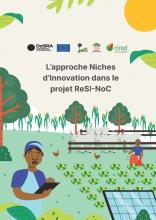Land Library
Welcome to the Land Portal Library. Explore our vast collection of open-access resources (over 74,000) including reports, journal articles, research papers, peer-reviewed publications, legal documents, videos and much more.
/ library resources
Showing items 1 through 9 of 1292.Au Nord Cameroun, plusieurs projets se sont succédés au fil du temps et ont promu des innovations techniques et technologiques contribuant au développement durable des systèmes agrosylvopastoraux.
Le Guide pour l’évaluation de l’agroécologie propose une démarche et des outils méthodologiques pour apprécier, d’une part, les effets des pratiques et des systèmes agroécologiques sur les performances agroenvironnementales et socio-économiques de l’agriculture et, d’autre part
Since the global crises in the 2000s, many foreign and domestic actors have acquired large tracts of land for food and biofuel crop cultivation and other purposes in Africa, often leading to the displacement of the African people living on customary land.
With over 14 million hectares allocated, Vietnam’s forest and forestland allocation has been one of the largest natural resource decentralization programs in the developing world over the last three decades.
Land expropriation has always been a hot spot of social conflicts. The land expropriation policy of Merging Villages and Living Together (MVLT) in rural areas has intensified conflicts due to insufficient financial compensation and “demolishing old houses before building new ones”.
‘Urbanization’ refers to the expansion of built-up areas caused by several factors. This study focuses on the urbanization process in Kathmandu, the capital of Nepal. Supervised classification was conducted in Google Earth Engine by using Landsat data for years 2001, 2011 and 2021.
Sustainable forest land management requires measuring and monitoring soil organic carbon.
Land uses and terrain characteristics would likely influence the types and spatial arrangements of forest patches, and generally, forest fragmentation.
Baseflow is an essential component of runoff, which is the dominant water resource for the dry season. To better manage water resources, it is vital to investigate the links between the multiple influencing factors and the baseflow for better prediction in light of global changes.









